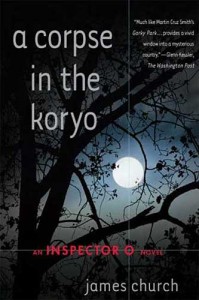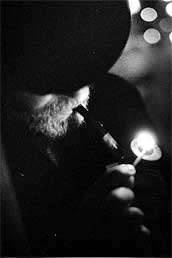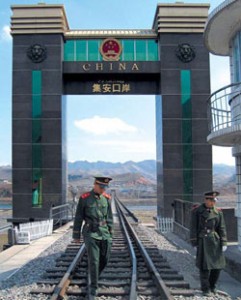“It’s not that we don’t like foreigners. It’s not foreigners, it’s ourselves we don’t like. In our minds, we are small, quivering, bowing, submissive, beaten, cowering dogs. If we like foreigners, it can only be because we are afraid, or currying favor, or kissing their feet.”
Author “Jam es Church,” a former western intelligence officer with “decades of experience” in Asia, including, presumably, North Korea, provides a stunning and profoundly interesting portrait of “real life” in this secretive and sometimes paranoid country. Inspector O, the main character in Church’s novel, works for the North Korean Ministry of People’s Security, but even at the level of inspector, he has no idea why he is assigned many of his tasks, nor does he know why he is often sent from the capital, Pyongyang, to outposts like Manpo and Kanggye on the Chinese border. All he knows is that his camera never has batteries that work, that finding a cup of tea is sometimes impossible, and that he does not rate a thermos. He expects to be tailed and spied upon, and he is accustomed to having his living quarters searched. He can trust no one, and he must constantly watch his own back to ensure that he does not accidentally discover information about crimes that he does not even know exist.
es Church,” a former western intelligence officer with “decades of experience” in Asia, including, presumably, North Korea, provides a stunning and profoundly interesting portrait of “real life” in this secretive and sometimes paranoid country. Inspector O, the main character in Church’s novel, works for the North Korean Ministry of People’s Security, but even at the level of inspector, he has no idea why he is assigned many of his tasks, nor does he know why he is often sent from the capital, Pyongyang, to outposts like Manpo and Kanggye on the Chinese border. All he knows is that his camera never has batteries that work, that finding a cup of tea is sometimes impossible, and that he does not rate a thermos. He expects to be tailed and spied upon, and he is accustomed to having his living quarters searched. He can trust no one, and he must constantly watch his own back to ensure that he does not accidentally discover information about crimes that he does not even know exist.

Though the inspector is inured to a life of uncertainly and to the inexplicable behavior of his superiors, most lovers of mysteries have developed a set of expectations about plots and characters. This one ignores all the “rules”–and is all the more fascinating, as a result. The biggest mystery here, in fact, is what is the mystery? Inspector O is assigned particular tasks, transferred to various outposts, seemingly at random, and then brought back again without warning, sometimes while he is involved in scenes of murder and bloodshed, and neither he nor the reader has any idea what is going on or why.
Any suggestion of a plot becomes even more ephemeral when it is interrupted regularly by an interrogation taking place in Prague by an Irish security official who is interviewing Inspector O. There are no clues about how these interrogations came about, why, or at whose behest.
The action begins when Inspector O is asked to observe and photograph a luxury car emerging from a tunnel in the countryside (a mission which fails because O’s camera batteries are dead), and continues with the discovery of the body of a Finn in the Koryo Hotel in Pyongyang. Soon, the violence increases with additional murders in other parts of the country to which O is sent. There are no clues about how, if at all, the murders are connected or about the interests that different governmental agencies may have in pursuing the investigations. The rivalry between Kang, Deputy Director of the Investigation Depart ment, and Kim, from Joint Headquarters, with O’s Ministry of People’s Security continues throughout the novel, and O is caught in the middle, never sure whether he can trust anyone, even Pak, his superior in the ministry. Nor does he really know what is at stake for any of the players in the other departments which are contesting for influence.
ment, and Kim, from Joint Headquarters, with O’s Ministry of People’s Security continues throughout the novel, and O is caught in the middle, never sure whether he can trust anyone, even Pak, his superior in the ministry. Nor does he really know what is at stake for any of the players in the other departments which are contesting for influence.
The ambiguities of the plot are paralleled by the ambiguities of character. Inspector O is “round” enough to keep readers interested—he is iconoclastic and refuses to wear his badges, and he is the grandson of a man who was a hero of the revolution—but we learn almost nothing else about him, other than the fact that he loves wood, enjoys trying to find its “heart,” and would love to spend his time creating furniture. He apparently has no family and spends his life working, sublimating most of his artistic talent and uniqueness in order to deal with the challenges of survival within a system which rewards conformity at the expense of originality.

If you are wondering, at this point, whether this is a book that might appeal to you, I have to admit that it came as a complete surprise to me. I appreciate the picture of North Korea and life within it, and I enjoyed the story enough to have sought (and purchased) copies of the next two novels in this series. I still don’t feel that I know Inspector O very well, but I don’t know of any other source of more reliable information about life in this country. The possible involvement of Japan, South Korea, and China in a conspiracy involving representatives from some of North Korea’s ministries raises intriguing questions and suggests that North Korea may not be as monolithic as we have previously thought. Existential in its concepts and ironic in its execution, The Corpse in the Koryo provides the interested reader with new ways of thinking about a “mystery nation,” North Korea, and offers a new way of thinking about its goals—and our own.
Notes: Also reviewed here: Church’s HIDDEN MOON and THE MAN WITH THE BALTIC STARE
The photograph here is the only photo available for this author, who maintains his secrecy regarding his real identity. http://us.macmillan.com
The elegant Koryo Hotel in Pyongyang is featured on this page: http://commons.wikimedia.org
Manpo, on the border between North Korea and China, to which Inspector was often sent, made news in August 2010 when leader Kim Jong-il made a surprise trip to China through this border station. Here is the story: http://english.chosun.com
